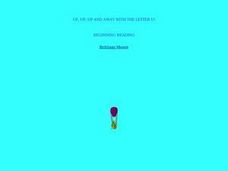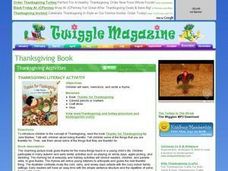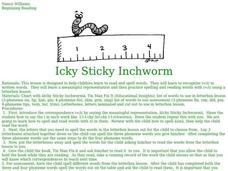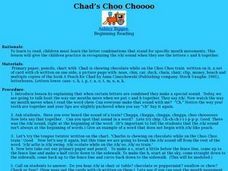Curated OER
Phonemic Awareness Worksheet 2
In this literacy worksheet, students find the phrases for each picture that corresponds and they practice reading the phrases to help with fluency.
Curated OER
Beginning Consonants
First graders practice with beginning consonant sounds, including identifying initial consonants and matching letter sounds to their corresponding letters. They recognize beginning consonant sounds by reading and listening to a story...
Curated OER
Phonics Instructional Routine: Read and Write Words with Consonant Digraphs
Use consonant digraphs to introduce learners to word patterns and high frequency words. They observe a chart with the digraphs /sh/, /ch/, /th/, and /wh/. After listening to each of these phonemes, scholars watch as the teacher...
Curated OER
PHONEMIC AWARENESS INFUSION
Students practice and utilize phonograms (word families) found in the patterns of frequently used words. They assess strategies to assist them in dividing long words as well as to develop their phonemic awareness to new vocabularies....
Curated OER
UP, UP, UP And Away with the Letter U
Learners practice developing phoneme awareness to identify the letter /u/ in spoken words as well as in its vocal gesture through various exercises. They assess phonemes through a letterbox lesson and the book, "Fuzz and the Buzz," by...
Curated OER
Thanksgiving Literacy Activity
Students explore why Thanksgiving is celebrated. In this cross-curriculum lesson, students listen to the book Thanks for Thanksgiving by Julie Markes, and complete the sentence frame "I am thankful for ____." Students practice phonemic...
Curated OER
Phonemic Awareness Infusion
Students explore and describe various kinds of work experiences and skills practicing the regular past tense -ed sounds. They practice pronouncing those sounds with verbs within their reading passages as well. In addition, they repeat...
Curated OER
The Creaky Door Says "ehhhh"
Study the long vowel sound /e/, as in a creaky door noise. Children repeat the sound and learn a chant. They use letters in letterboxes to make words with the /e/ sound before reading a book and writing a message about their favorite...
Curated OER
Achoo!
Focus in on the digraph ch. Young readers will hear the sound, print the letters, and read A Peach for Chad. Can your youngsters think of any more words that use the target sound?
Curated OER
Icky Fingers
Which i sound is used in the word icky? Kindergarteners and first graders listen to the short /i/ sound. They practice shaking their fingers to indicate icky when they hear the target sound. Then they practice reading a poster with the...
Curated OER
Beginning and Ending Sounds - Lesson 1 of 2
Stamp, slap, and clap! Emergent readers demonstrate their awareness of the initial, medial vowel, and final sounds in spoken, short vowel, single-syllable words with a stamp/slap/clap activity. After identifying the letters and sounds of...
Curated OER
Mmm, Mmm ... Good!
Help primary students learn the /m/ sound. As they listen as the teacher introduces the "Secret Code" of language they will practice the /m/ sound by rubbing their tummies as if eating something good. They also practice hearing and...
Curated OER
Phonics: Decode and Write Words with Blends
Kids see, say, then count the phonemes they hear in a series of simple words. They practice counting phonemes with the teacher, then sound out the same word on their own. As they count each phoneme they write it down on their paper. A...
Curated OER
Decode and Write Words with More Than One Syllable
Practice sounding out multi-syllable words with this scaffolded lesson. Learners decode words by segmenting them into phonemes and combining the sounds. Your lines are in bold here, but you can easily use this simply as an outline...
Curated OER
OW! I stubbed by toe
Drill and practice the /ow/ sound! Kids practice recognizing pictures that begin with the ou=/ou/ correspondence. They experience a letterbox lesson to help implement this task before them as well as reading the story, The Napping House,...
Curated OER
Blast-Off to Blending
Practice working with different phonemes in consonants and vowels. Sounds are written on squares that get put on a rocket to "blast off" and meet other sounds. The teacher first models blending, then reads the new words. Young readers...
Curated OER
Sssssssss
Students experience the strategy of phoneme recognition to recognize /s/ in spoken words, including plurals, and in writing. They encounter the book Summer Fun by Lucy Lawrence and the tongue twister "Miss Sam saw a sneaky slimy snake in...
Curated OER
Letter Sound Fluency
How fast can you go? Test scholars' letter sound recognition with a timed game. Using letter cards of all the letters you've learned so far, learners take turns flipping cards and correctly saying the letter sound. Model this first,...
Curated OER
Icky Insect Is In Icky Sticky Ink
Practice the strategy of letter-sound correspondence when identifying the short vowel /i/ sound in written and spoken words. The teacher recites the tongue twister "Icky insect is in icky sticky ink," while listeners repeat. Letter boxes...
Curated OER
Icky Sticky Inchworm
Use the meaningful example "Icky Sticky Inchworm" to demonstrate the /i/ sound. Then have learners take out letter boxes and spell simple words like six, lip, him, pin, slim, grin, etc.
Curated OER
Chad's Choo Choooo
Choo, choo! Do your youngsters like trains? After studying the target sound, have your learners read A Peach for Chad. Do a class read and an independent read to increase fluency. At the lesson's close, consider creating a ch train...
Curated OER
Shhh! Be Quiet
Teach the digraph sh with your learners. First, model the sound the digraph makes. Then, have learners spell a variety of words that use the target sound. Finally, read Shoe Man, where learners can hear the words in context.
Curated OER
Cheese Please
Do you like cheese? What sound does the word start with? Learn all about the /ch/ sound and what other words make the same sound.
Curated OER
Introduce Onset-Rime Blending
Mico (or your favorite puppet) helps emergent readers recognize words from segmented phonemes. Explain to learners that he struggles with pronouncing words and needs their help. Model how Mico segments sounds in single-syllable words....

























